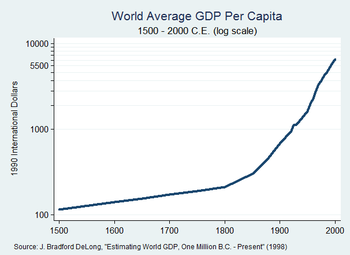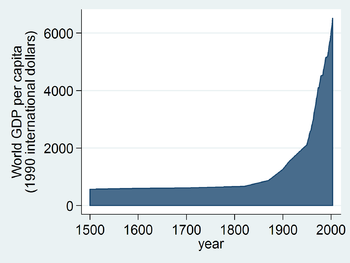World economy
This article needs to be updated. (January 2012) |
This article needs additional citations for verification. (September 2011) |
| Statistics | |
|---|---|
| Population | 7,000,000,000 (October 31, 2011)[1] |
| GDP | Currency: US$61.96 trillion, €55.8 trillion (2010 est.)[2] PPP: US$74.00 trillion, €60 trillion (2010 est.)[2] |
GDP growth | Per capita (PPP): -0.8% (2009 est.) |
GDP per capita | Currency: US$7,178, €5,000 PPP: US$10,500, €7,500 |
Millionaires (US$) | ~10 million i.e. ~0.15% (2009) |
| Unemployment | 30% combined unemployment and underemployment in many non-industrialized countries. Developed countries typically 4-12% unemployment. |
| Trailing-ten-years. Most numbers are from the UNDP from 2002, some numbers exclude certain countries for lack of information. All values, unless otherwise stated, are in US dollars. | |
The world economy, or global economy, generally refers to the economy, which is based on economies of all of the world's countries, national economies. Also global economy can be seen as the economy of global society and national economies – as economies of local societies, making the global one. It can be evaluated in various kind of ways. For instance, depending on the model used, the valuation that is arrived at can be represented in a certain currency, such as 2006 US dollars or 2005 euros.
It is inseparable from the geography and ecology of Earth, and is therefore somewhat of a misnomer, since, while definitions and representations of the "world economy" vary widely, they must at a minimum exclude any consideration of resources or value based outside of the Earth. For example, while attempts could be made to calculate the value of currently unexploited mining opportunities in unclaimed territory in Antarctica, the same opportunities on Mars would not be considered a part of the world economy—even if currently exploited in some way—and could be considered of latent value only in the same way as uncreated intellectual property, such as a previously unconceived invention.
Beyond the minimum standard of concerning value in production, use, and exchange on the planet Earth, definitions, representations, models, and valuations of the world economy vary widely.
It is common to limit questions of the world economy exclusively to human economic activity, and the world economy is typically judged in monetary terms, even in cases in which there is no efficient market to help valuate certain goods or services, or in cases in which a lack of independent research or government cooperation makes establishing figures difficult. Typical examples are illegal drugs and other black market goods, which by any standard are a part of the world economy, but for which there is by definition no legal market of any kind.
However, even in cases in which there is a clear and efficient market to establish a monetary value, economists do not typically use the current or official exchange rate to translate the monetary units of this market into a single unit for the world economy, since exchange rates typically do not closely reflect worldwide value, for example in cases where the volume or price of transactions is closely regulated by the government.
Rather, market valuations in a local currency are typically translated to a single monetary unit using the idea of purchasing power. This is the method used below, which is used for estimating worldwide economic activity in terms of real US dollars or euros. However, the world economy can be evaluated and expressed in many more ways. It is unclear, for example, how many of the world's 6.8 billion people have most of their economic activity reflected in these valuations.
In 2011, the largest economies in the world with more than $2 trillion, €1.25 trillion by nominal GDP are the United States, China, Japan, Germany, France, the United Kingdom, Brazil, and Italy. The largest economies in the world with more than $2 trillion, €1.25 trillion by GDP (PPP) are the United States, China, Japan, India, Germany, Russia, the United Kingdom, Brazil, and France.
Economy – overview
Twenty Largest Economies by GDP at Given Years
The following is a list of twenty largest economies by nominal GDP at a specific year according to International Monetary Fund.
| IMF GDP Figures[3]
The following is a list of twenty largest economies by GDP (PPP) at a specific year according to International Monetary Fund[4] and the World Bank.[5][6] 1980 – 1990 - United States and Japan lead expansionAt exchange rates, the economic output of 112 markets expanded by $10.7 trillion from 1980 to 1990. The economic output of 34 markets contracted by $276.9 billion from 1980 to 1990. The five largest contributors to global output contraction are Argentina at 24%, Saudi Arabia at 17%, Nigeria at 11%, Venezuela at 8%, and Vietnam at 8%. At purchasing power parity, the economic output of 145 markets expanded by $12.1 trillion from 1980 to 1990. The economic output of 2 markets contracted by $3.5 billion from 1980 to 1990. The two contributors to global output contraction are Lebanon at 70% and Libya at 30%. The following two tables are lists of twenty largest economies by incremental GDP from 1980 to 1990 by International Monetary Fund.
1990 – 2000 - United States dominates expansionAt exchange rates, the economic output of 122 markets expanded by $10.7 trillion from 1990 to 2000. The economic output of 29 markets contracted by $94.2 billion from 1990 to 2000. The five largest contributors to global output contraction are Italy at 37%, Finland at 18%, Bulgaria at 9%, Algeria at 8%, and the Democratic Republic of Congo at 5%. At purchasing power parity, the economic output of 148 markets expanded by $16.9 trillion from 1990 to 2000. The economic output of 3 markets contracted by $17.8 billion from 1990 to 2000. The three contributors to global output contraction are Bulgaria at 64%, the Democratic Republic of Congo at 29% and Sierra Leone at 7%.
2000 – 2010 – Rise of Developing and Emerging Economies2000 – 2006 – United States still leads, but China is catching up At exchange rates, the economic output of 176 markets expanded by $17.4 trillion from 2000 to 2006. The five largest contributors to global output expansion are the United States at 20%, China at 9%, Germany at 6%, the United Kingdom at 6%, and France at 5%. The economic output of 4 markets contracted by $94.2 billion from 2000 to 2006. The three largest contributors to global output contraction are Japan at 80%, Argentina at 19%, and the Uruguay at 1%. At purchasing power parity, the economic output of 180 markets expanded by $19.2 trillion from 2000 to 2006. The five largest contributors to global output expansion are the United States at 18%, China at 17%, India at 6%, Japan at 5%, and Russia at 4%. 2007 – China leads expansion The economic output by nominal GDP of 183 markets expanded by $6.4 trillion during 2007. China accounted for 12% while the United States accounted for 10%, Germany accounted for 6%, and the United Kingdom accounted for 6% of the global output expansion. 2008 – credit crisis begins The economic output of 171 markets expanded by $5.8 trillion during 2008. China accounted for one-sixth of the global output expansion. The economic output of 11 markets contracted by $267 billion during 2008. The United Kingdom accounted for one-half while South Korea accounted for two-fifth of the global output contraction. Though the crisis first affected most countries in 2008, it was not yet deep enough to reverse growth. 2009 – credit crisis spreads At exchange rates, the economic output of 127 markets contracted by $4.1 trillion during 2009. The United Kingdom was the largest victim accounting for 12% while Russia accounted for 11% and Germany accounted for 8% of the global output contraction. The economic output of 56 markets expanded by $767.1 billion during 2009. China accounted for 61% while Japan accounted for 20% and Indonesia accounted for 4% of the global output expansion. At purchasing power parity, the economic output of 79 markets contracted by $1.4 trillion during 2009. The United States was the largest victim accounting for 18% while Japan accounted for 17% and Russia accounted for 10% of the global output contraction. The economic output of 104 markets expanded by $1.5 trillion during 2009. China accounted for 56% while India accounted for 17% and Indonesia accounted for 3% of the global output expansion. 2010 – recovery At exchange rates, the economic output of 148 markets expanded by $5.3 trillion during 2010. The five largest contributors to global output expansion are China at 17%, the United States at 10%, Brazil at 9%, Japan at 8%, and India at 5%. The economic output of 35 markets contracted by $338.5 billion during 2010. The five largest contributors to global output contraction are France at 22%, Italy at 18%, Spain at 17%, Venezuela at 10%, and Germany at 7%. At purchasing power parity, the economic output of 169 markets expanded by $4.2 trillion during 2010. The five largest contributors to global output expansion are China at 25%, the United States at 13%, India at 10%, Japan at 5%, and Brazil at 4%. The economic output of 14 markets contracted by $17.8 billion during 2010. The five largest contributors to global output contraction are Greece at 67%, Venezuela at 19%, Romania at 5%, Haiti at 3%, and Croatia at 2%. IMF's economic outlook for 2010 noted that banks faced a "wall" of maturing debt, which presents important risks for the normalization of credit conditions. There has been little progress in lengthening the maturity of their funding and, as a result, over $4 trillion in debt is due to be refinanced in the next 2 years.[11]` The following two tables are lists of twenty largest economies by incremental GDP from 2000 to 2010 by International Monetary Fund.
2010 – 2016 The BRICs lead economic growth.At exchange rates, the economic output of the world is expected to expand by US$28.7 trillion, €20 trillion from 2010 to 2016.[14] At purchasing power parity, the economic output of 183 markets is expected to expand by US$29.1 trillion, €25 trillion from 2010 to 2016.[15] The following two tables are predictive lists of forty largest economies by incremental GDP from 2010 to 2016 by International Monetary Fund.
Statistical indicatorsEconomy
Employment  
Industries
Energy
Cross-border
Gift economy
CommunicationsTelephones – main lines in use: 843,923,500 (2007)
TransportTransportation infrastructure worldwide includes:
Military
Economic StudiesTo promote exports, many government agencies publish on the web economic studies by sector and country. Among these agencies include the USCS (US DoC) and FAS (USDA) in the United States, EDC and AAFC in Canada, Ubifrance in France, UKTI in the UK, HKTDC and JETRO in Asia, Austrade and NZTE in Oceania. Through Partnership Agreements, The Federation of International Trade Associations publishes studies from several of these agencies (USCS, FAS, AAFC, UKTI, HKTDC), as well as other non-governmental organizations on its website GlobalTrade.net. See also
Regional economies:
Events: Lists:
References
External links |
||||||||||||||||||||||||||||||||||||||||||||||||||||||||||||||||||||||||||||||||||||||||||||||||||||||||||||||||||||||||||||||||||||||||||||||||||||||||||||||||||||||||||||||||||||||||||||||||||||||||||||||||||||||||||||||||||||||||||||||||||||||||||||||||||||||||||||||||||||||||||||||||||||||||||||||||||||||||||||||||||||||||||||||||||||||||||||||||||||||||||||||||||||||||||||||||||||||||||||||||||||||||||||||||||||||||||||||||||||||||||||||||||||||||||||||||||||||||||||||||||||||||||||||||||||||||||||||||||||||||||||||||||||||||||||||||||||||||||||||||||||||||||||||||||||||||||||||||||||||||||||||||||||||||||||||||||||||||||||||||||||||||||||||||||||||||||||||||||||||||||||||||||||||||||||||||||||||||||||||||||||||||||||||||||||||||||||||||||||||||||||||||||||||||||||||||||||||||||||||||||||||||||||||||||||||||||||||||||||||||||||||||||||||||||||||||||||||||||||||||||||||||||||||||||||||||||||||||||||||||||||||||||||||||||||||||||||||||||||||||||||||
